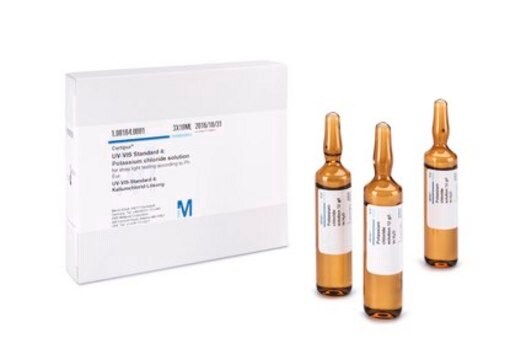1.09118
Potassium dichromate solution
c(K₂Cr₂O₇) = 1/24 mol/l (0.25 N), ready-to-use volumetric solution for titration, Titripur®
Synonyme(s) :
Chromic acid solution
About This Item
Produits recommandés
Nom du produit
Potassium dichromate solution, c(K2Cr2O7) = 1/24 mol/l (0.25 N), Titripur®
Niveau de qualité
Gamme de produits
Titripur®
Forme
liquid
Qualité
Analyzed in our ISO 17025 accredited QC lab
Capacité de réaction
reaction type: Redox Reactions
Concentration
1/24 M
Technique(s)
titration: suitable
pH
3.8 (20 °C in H2O)
Densité
1.01 g/cm3 at 20 °C
Température de stockage
15-25°C
Application
- The Anticoccidial Effect of Alcoholic Vitis vinifera Leaf Extracts on Eimeria papillate Oocysts Isolated in Mice In Vitro and In Vivo.: This study investigates the anticoccidial properties of Vitis vinifera leaf extracts, using potassium dichromate solution as a disinfectant in the preparation of oocysts for analysis. The analytical approach includes evaluating the effectiveness of the extracts against Eimeria papillate oocysts (Murshed et al., 2023).
- Evaluation of the Anticoccidial Activity of Sheep Bile against Eimeria stiedae Oocysts and Sporozoites of Rabbits: An In Vitro Study.: This research explores the anticoccidial activity of sheep bile, employing potassium dichromate solution in the process of oocyst disinfection and preparation. The study provides insights into the efficacy of sheep bile as an anticoccidial agent (Murshed et al., 2022).
- Time-resolved XANES speciation studies of chromium on soils during simulated contamination.: This paper presents a detailed analysis of chromium speciation in soils using time-resolved XANES. Potassium dichromate solution is used to simulate contamination, allowing for the study of chromium′s behavior and speciation over time (Kappen et al., 2008).
Caractéristiques et avantages
This volumetric solution is analyzed by our calibration laboratory D-K-15185-01-00 which is accredited according to DIN EN ISO/IEC 17025 for analysis of amount-of-substance concentrations in volumetric solutions by DAkkS (Deutsche Akkreditierungsstelle - German National Accreditation Body). The accreditation certificate can be found at www.sigmaaldrich.com/ISO17025.
Conditionnement
Remarque sur l'analyse
Amount-of-substance concentration 0.04146 - 0.04188 mol/L
Measurement uncertainty ± 0.00013 mol/L
Traceability NIST SRM
The concentration is determined by volumetric titration and refers to 20°C.
The amount-of-substance concentration of this volumetric solution is determined with standardized sodium thiosulfate solution (article number 1.09147). The sodium thiosulfate solution is standardized and traceable to a primary standard reference material (SRM) from the National Institute of Standards and Technology, Gaithersburg, USA (NIST SRM 136 potassium dichromate) by means of volumetric standard potassium iodate (article number 1.02404), certified reference material according to ISO 17034, analyzed by our accredited calibration laboratory of Merck KGaA, Darmstadt, Germany according to DIN EN ISO/IEC 17025. The uncertainty is expressed as expanded measurement uncertainty with a coverage factor k=2 covering a confidence level of 95%.
Note: The titer is a correction factor to correct for variations of the volumetric solution, the titration equipment, the temperature and other laboratory conditions. For correct titration results it is recommended to determine a titer with the laboratory specific equipment and under laboratory specific conditions directly after opening a new bottle and at regular time intervals.
Informations légales
Produit(s) apparenté(s)
Mention d'avertissement
Danger
Mentions de danger
Conseils de prudence
Classification des risques
Aquatic Chronic 3 - Carc. 1B - Muta. 1B - Repr. 1B
Code de la classe de stockage
6.1D - Non-combustible, acute toxic Cat.3 / toxic hazardous materials or hazardous materials causing chronic effects
Classe de danger pour l'eau (WGK)
WGK 3
Point d'éclair (°F)
Not applicable
Point d'éclair (°C)
Not applicable
Certificats d'analyse (COA)
Recherchez un Certificats d'analyse (COA) en saisissant le numéro de lot du produit. Les numéros de lot figurent sur l'étiquette du produit après les mots "Lot" ou "Batch".
Déjà en possession de ce produit ?
Retrouvez la documentation relative aux produits que vous avez récemment achetés dans la Bibliothèque de documents.
Les clients ont également consulté
Notre équipe de scientifiques dispose d'une expérience dans tous les secteurs de la recherche, notamment en sciences de la vie, science des matériaux, synthèse chimique, chromatographie, analyse et dans de nombreux autres domaines..
Contacter notre Service technique








